- Home
- Balogun Ojetade
Steamfunkateers
Steamfunkateers Read online
Steamfunkateers
The Steamfunk Role Playing Game
Writing and Design: Balogun Ojetade
Cover Art: Caanan White & Jesse Heagy
Interior Art: Caanan White, Stanley Weaver and Marcellus Shane Jackson
Playtesters: Akinbobola Donaldson, Sangobunmi Gray, Oluade Ojetade, Oriyemi Ojetade, Sangowunmi Rufus, Amosun “Flux” Singleton
Copyright © 2018 Balogun Ojetade
All rights reserved.
ISBN: 1727675274
ISBN-13: 978-1727675276
DEDICATION
I dedicate this book to the pioneers of Steamfunk: Milton J. Davis, Valjeanne Jeffers, Maurice Broaddus and yes, li’l ol’ me. May we all continue to tell great steamy and funky tales until the wheels fall off.
CONTENTS
Acknowledgments
i
The Game
3
Taking Action
11
Character Creation
28
Descriptors
37
Skills & Feats
57
The Brushed
94
The Steamfunkateers Universe
149
“Be Free” Adventure
229
Recommended Reading
298
ACKNOWLEDGMENTS
I would like to thank all of my fans, playtesters, and supporters. You—my fellow Steamfunkateers—are truly Blacknificent, Blacktastic, Blaxcellent and cooler than a polar bear on Christmas in an air-conditioned igloo. Keep being you
THE GAME
In Steamfunkateers you take on the role of an adventurer that is—according to Harriet Tubman and many other people of repute—”Brushed by the Hand of God… or the Other One.” You can choose from eleven unique Steamfunk Archetypes and build your character as you see fit. No classes, no restrictions. There are heists, chases, escapes, dangerous bargains, bloody skirmishes, deceptions, betrayals, victories, and deaths.
The Steamfunkateers system is fast-paced, intuitive, and leaves as much as possible up to you, the Steamfunkateer. Playing our game, you will live and experience the thrill of fighting with—or against—the powerful Harriet Tubman; of building an airship with George Washington Carver; of freeing slaves in Georgia; or of being John Henry, battling a horde of rampaging werewolves.
Welcome to Steamfunkateers. Hop aboard the Airship Sweet Chariot and let’s take flight to a world of Saviors, Soldiers and Steam; of Gears, Guns and Gaslight; of Abominations, Automatons and Abolitionists. Hop on board, fellow Steamfunkateers. It’s sure to be the wildest ride of your life!
WHAT IS STEAMFUNK?
Steamfunk is defined as a philosophy or style of writing and visual aesthetic that combines the African and/or African Diasporan culture and approach to life with that of the steampunk philosophy and/or steampunk fiction and cosplay.
Steampunk has the power to rip open the 19th Century’s belly and examine its clockwork guts – and to rearrange those guts in new ways – but most Steampunk authors – and indeed most Steampunks – choose to avoid the issues of racism, sexism, classism, colonialism and imperialism.
Steamfunk authors, thankfully, choose to address these very same issues, for we know that to avoid them—especially since there is such a wealth of Steampunk tales to be told from a Black perspective—is to perpetuate the Big Steampunk Lie.
Yes… lie; a lie by omission; also known as the ‘suppression of evidence’.
This type of lie is more subtle. It has the advantage that you can’t get caught in a lie, because everything that you say is true. You just fail to mention all of those bothersome little facts that do not support your point of view. Should someone point out one of those annoying – and unmentioned – facts, you can feign innocent ignorance, or claim that the fact is really just an unimportant, trivial detail, not worth mentioning.
Thus the Victorian Era/Wild West is represented in most Steampunk as merely an age of exploration and invention. A renaissance, if you will. A very interesting – and deceptive – way of describing an era in which the “explorers” who, at best, unintentionally and, at worst – and far more often, very intentionally – brought with them the forces of colonialism and imperialism throughout the world.
The “Wild West” of North America systematically robbed the indigenous people of their lands and murdered them wholesale while also oppressing and vilifying Asians. In the South and East of North America, people of African descent suffered horrors under the yoke of chattel slavery and things did not get much better after the Civil War. To romanticize such an era; to paint such a dystopian reality as a rose-colored (well, various shades of brown in Steampunk) utopia is the ‘Big Steampunk Lie’ of which I speak.
Now, I am not saying all Steampunk stories should be dark and foreboding. However, we should tackle issues of race, sex and class in our stories to some degree. So many incredible and thought-provoking stories are waiting to be told… if we care to tell them.
In Steamfunkateers, these stories, which must be told, will be shouted from our Funkadelic Airships. And not just told, they will be lived by the characters you create.
Full steam ahead!
THE PLAYERS
Each player creates a character and works with the other players to create the airship crew, organization, Underground Railroad “station,” military squadron, or other team to which their characters belong. Each player strives to bring their character to life as an interesting, daring player character who reaches boldly beyond their current safety and means. This is the players’ core responsibility: they engage with the premise of the game, seeking out interesting opportunities, taking big risks against powerful foes and sending their characters into danger and epic adventures.
The players work together with the Game Master – also known as the GM – to establish the tone and style of the game by making judgment calls about the tinkerers, dice, and consequences of actions. The players take responsibility as co-authors of the game with the GM.
THE CHARACTERS
There are several character archetypes to choose from, each representing a different skill-set and sphere of knowledge:
Air Pirate: One of the quintessential Steampunk characters. Air pirates are bad, bold, and armed to the teeth.
Adventurer/Explorer: Their reason for being is to boldly go where no one has gone before; to experience new things; and to discover new places.
Aviator: Whether military, or a rogue; whether they’re flying a bi-plane, a zeppelin, or a space ship; they are tough, brave, and even a bit gallant, especially in contrast to Air Pirates.
Dandy/Femme Fatale: They use their wiles and charms to get what they want, sometimes at the expense of others.
Hunter/Fighter: Monster hunters are all about firepower and skill in combat. They stay armed with stakes, silver bullets, and strange, arcane-looking weaponry. Soldiers, sailors and other military personnel are highly disciplined, well-trained and either loyal followers or deserters, who refuse to fight for a corrupt nation.
Mad Scientist/Inventor: Another quintessential Steampunk character, they embody the steam in steampunk, discovering new things, solving problems, and occasionally blowing things up.
Magician/Occultist: The conjure-man; the witch; the illusionist—the great men and women whose lives are bolstered, or broken, by the arts of legerdemain, divination and prestidigitation. The virtuosos of voodoo, stage magic, fortune-telling and mesmerism.
Tinkerer: A bit of a twist on the Scientist/Inventor. Where the Inventor is creating things from scratch, the tinkerer is improving on things, often on the fly, or perhaps just trying to get things to work; making do with what they have.
Philosopher/Scholar: They like old, r
are books and wax poetic about the classics; they talk too much about things no one cares about or prefer books to people.
Socialite/Lady/Gentleman: Often based on Victorian aristocracy, they can often embody the refinement and social norms we associate with the upper class of that era. Many times they serve as patrons for the scholars, adventurers, and inventors.
Street Sparrow/Scrappy Survivor: These are the street urchins, your pickpockets and beggars. Hungry and dirty, they do what they need to do to survive.
Reformer: They could be suffragettes or seeking to get rid of child labor or protesting imperialism, they are working to make the world a better place, often loudly and not always peacefully and without scandal.
Character archetypes aren’t unique. You can mix and match, or play a crew that is all of one type. It’s up to you.
THE GAME MASTER
The GM establishes the dynamic world around the characters, from the corrupt and wicked rulers of the city and the violent and desperate criminal underworld to the bakers, the constables, the Voodoo Queen of New Orleans and the War Chief of Oyo. The GM plays all the non-player characters in the world by giving each one a concrete desire and preferred method of action.
The GM helps organize the conversation of the game so it’s pointed toward the interesting elements of play. The GM isn’t in charge of the story and doesn’t have to plan events ahead of time. They present interesting opportunities to the players then follow the chain of action and consequences wherever they lead.
PLAYING A SESSION
So, what’s it like to play? A session of Steamfunkateers is like an episode of a TV show. There are one or two main events, plus maybe some side-story elements, which all fit into an ongoing series. A session of play can last anywhere from two to six hours, depending on the preferences of the group.
During a session, the crew of player characters works together to accomplish some goal (presented to them by an NPC or by creating their own operation). The PCs take actions, suffer consequences, and finish the operation (succeed or fail). Then the crew has downtime, during which they recover, pursue side-projects, and indulge their vices. After downtime, the players once again look for a new opportunity or create their own goals and pursuits, and we play to find out what happens next.
As your group gets more familiar with the game, you might be able to pack more into a session, even doing two scores in an evening of play.
After a dozen sessions or so, you might decide to have a break in the flow of the story and start up “season two” of the “series”—possibly with a slightly different cast of characters and a new starting situation.
BEFORE YOU START
Read this book once through. You won’t immediately understand everything until you see it play. You won’t get all the rules right the first time. That’s fine; the rules will make more sense when you read them again after you play. The system of Steamfunkateers is designed to be learned as an ongoing process—each time you play you’ll get better until everything is second nature.
You might be the only person in the game group that’s read the book—that’s fine, too, but then it’s on you to convey everything to the other players, so that’s a job you’re taking on.
What the other players will need to do, though, is buy into the idea of the game. Tell them it’s a game about daring player characters during the time of the Civil War, Reconstruction, or the Wild West. Mention a few touchstones that they’re familiar with” “It’s like the League of Extraordinary Gentlemen, or Penny Dreadful, but starring Black people,” or say, “Think Frederick Douglass commanding an airship that flies runaway slaves to Freedom, or Harriet Tubman doing battle with a horde of rampaging ghuls.” If their eyes haven’t lit up yet, maybe this game isn’t going to click with them. That’s fine. You can always play a different game with that person some other time. You want to have full buy-in from your players.
WHAT YOU NEED TO PLAY
Getting into a game of Steamfunkateers is very simple. You need:
Several people. One of you is going to be the Game-Master (or “GM”), and everyone else is going to be a player.
A character sheet—one per player—and some extra paper for note-taking. We’ll talk about what’s on the character sheet below. GMs, any important characters you play might have a character sheet also.
At least 6 six-sided dice.
MAKING THE GAME YOUR OWN
Roleplaying is, at its essence, an expressive act. Everything in this book exists to help you and your friends express yourselves by creating collaborative social fiction about a team of daring player characters.
Some elements of the game setting are meant to emerge in play, as an act of discovery and creative interpretation. There are several possible concepts, from which you are free to pick and choose as you go along—making the game your own as you do.
THE CONVERSATION
A roleplaying game is a conversation between the GM and the players, punctuated by dice (or the draw of dice—used when playing Ki-Khanga: The Sword and Soul Role Playing Game) to inject uncertainty and surprising turns.
The GM presents the fictional situation in which the player characters find themselves. The players determine the actions of their characters in response to the situation. The GM and the players together judge how the game systems are engaged. The outcomes of the players’ actions and the checks of the dice then change the situation, leading into a new phase of the conversation—new situations, new actions, new judgments, new checks—creating an ongoing fiction and building “the story” of the game, organically, from a series of discrete moments.
No one is in charge of the story. The story is what happens as a result of the situation presented by the GM, the actions the characters take, the outcomes of the dice, and the consequences that result. The story emerges from the unpredictable collision of all of these elements. You play to find out what the story will be.
JUDGMENT CALLS
Since roleplaying is a collaborative, expressive act, not a purely strategic endeavor, you’ll need to make judgment calls. By making these choices, the players and GM, together, establish a style, tone, and form of fiction unique to their instance of play. Steamfunkateers is designed to bring these judgment calls to the forefront and make them explicit tools of the game.
When you play, you’ll make several key judgment calls. Everyone contributes, but either the players or the GM gets final say for each:
Which actions are reasonable as a solution to a problem? Can this person be swayed? Must we get out the tools and tinker with this old rusty automaton, or does it just need some grease on its joints? The players have final say.
How dangerous and how effective is a given action in this circumstance? How risky is this? Can this person be swayed very little or a whole lot? The GM has final say.
Which consequences are inflicted to manifest the dangers in a given circumstance? Does this fall from the roof break your leg? Do the constables merely become suspicious or do they already have you trapped? The GM has final say.
Does this situation call for a hand of dice? The GM has final say.
Which events in the story will bring about character advancement? Did you express your character’s beliefs, drives, heritage, or background? You tell us. The players have final say.
The particular choices you make will create your own unique form of Steamfunkateers. You’ll say something about the world and the characters, about Steamfunk fiction and aesthetics, and even about the human condition. What you say is entirely up to YOU.
TAKING ACTION
Players, some of the things you’ll do in a Steamfunkateers game require you to roll your dice pool to see if your character succeeds or not. You will always roll your dice when you’re opposing another character with your efforts, or when there’s a significant obstacle in the way of your effort. Otherwise, just say what your character does and assume it happens.
Throughout this book you will see +1d, +2d, and so on. The “d�
�� means “die/dice,” so a +1d means a bonus of one die is given to a player’s (or GM’s) dice pool; +2d means a bonus of two dice is given. So, if you receive a +2d bonus, the GM will give you an extra two dice, or you can add the two dice to your pool from your collection of dice if you have one.
Rolling the Dice
When you need to roll dice in Steamfunkateers, pick up your dice—the number of dice in your hand will depend on your level of skill, conditions, what you are trying to accomplish and any special abilities you possess—then roll them.
When a challenge, contest, or conflict erupts during play, all players declare what their characters’ goals are in the immediate action. The characters roll the appropriate number of dice. The GM also rolls dice because he controls either an NPC or represents another challenge.
Success for the PC hinges on beating the GM, or the opponent(s). The order of rolling the dice is as follows:
The player with the highest Spot or Empathy skill rank (see Conflicts, below) rolls all his applicable dice first, and the subsequent players, in order of Empathy rank, rolls their dice first. If more than one PC has equal Spot or Empathy, both players roll a single die. Highest score wins initiative (i.e., goes first)
On your turn, describe what your PC is attempting to do.
Roll all the dice in your dice pool (see below) at once. For your action to succeed, at least one die must come out a six. If you roll more than one six, you unlock bonus effects.

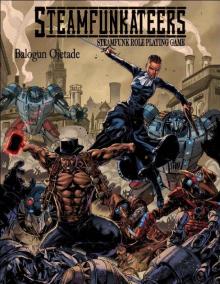 Steamfunkateers
Steamfunkateers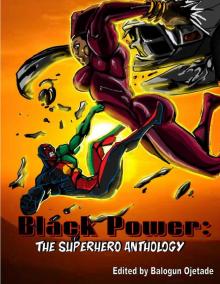 Black Power- The Superhero Anthology
Black Power- The Superhero Anthology Gunsmoke Blues
Gunsmoke Blues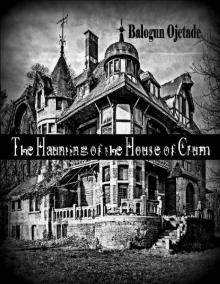 The Haunting of the House of Crum
The Haunting of the House of Crum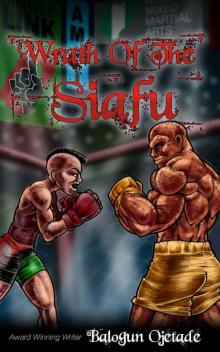 Wrath of the Siafu- A SIngle Link
Wrath of the Siafu- A SIngle Link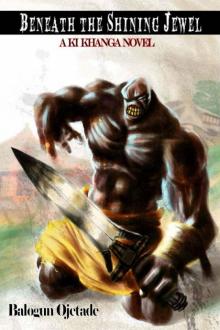 Beneath the Shining Jewel
Beneath the Shining Jewel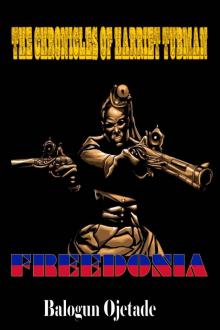 The Chronicles of Harriet Tubman- Freedonia
The Chronicles of Harriet Tubman- Freedonia A Haunting in the SWATS (The Savannah Swan Files Book 1)
A Haunting in the SWATS (The Savannah Swan Files Book 1)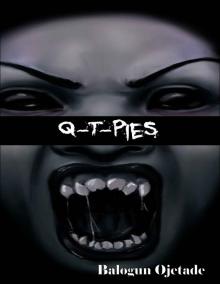 Q-T-Pies (The Savannah Swan Files Book 0)
Q-T-Pies (The Savannah Swan Files Book 0)